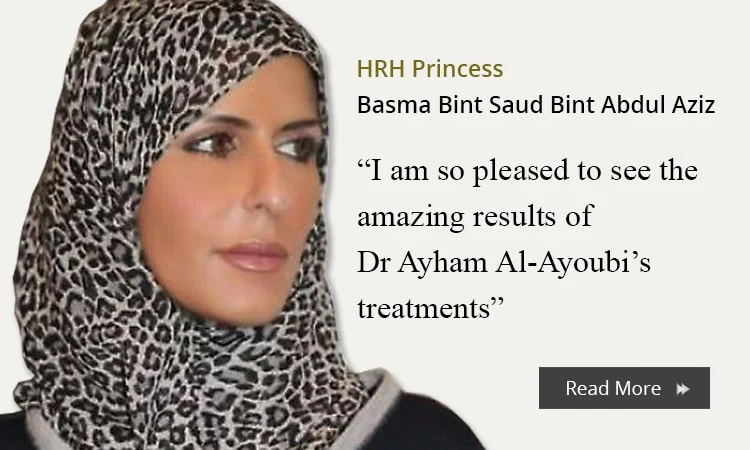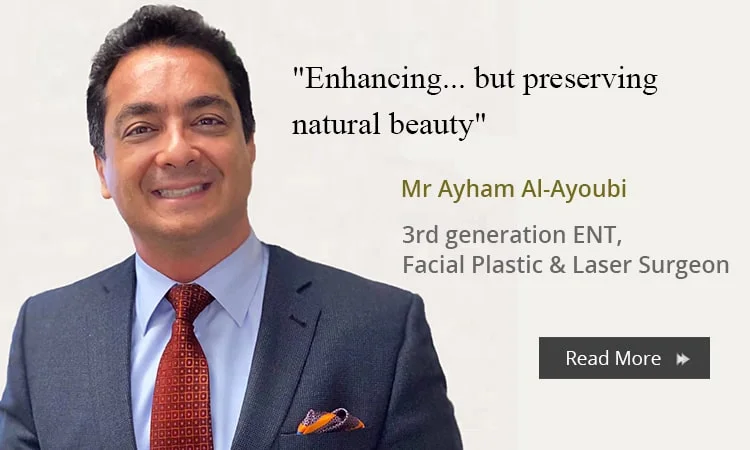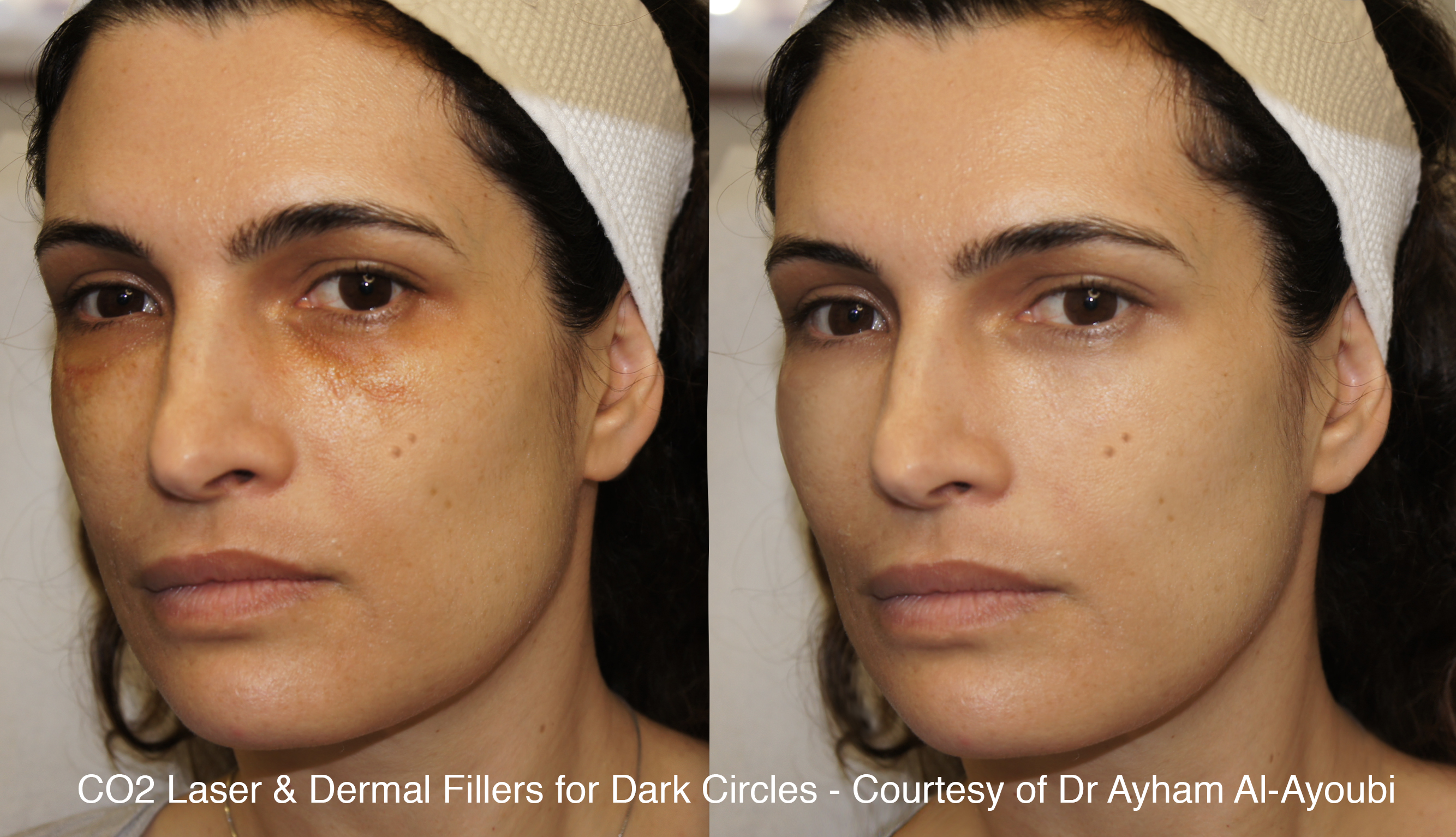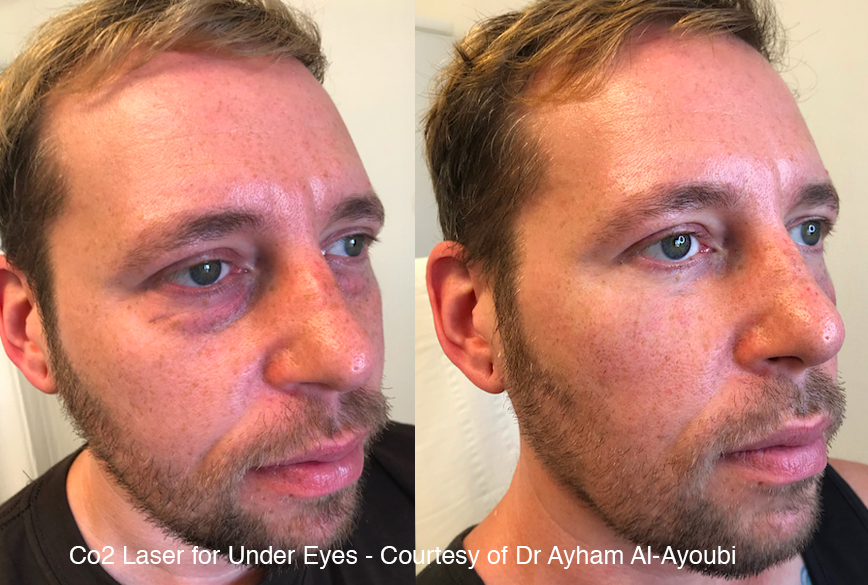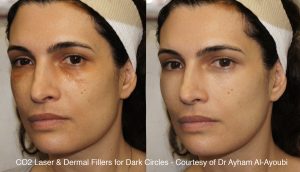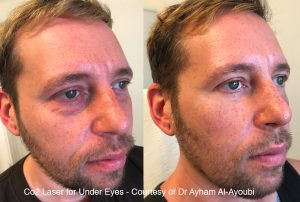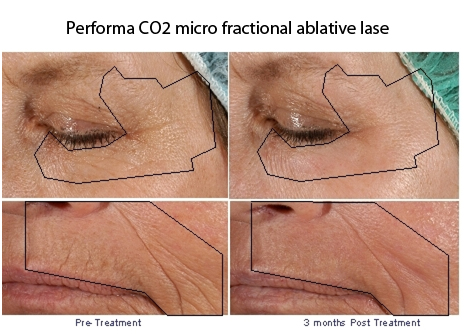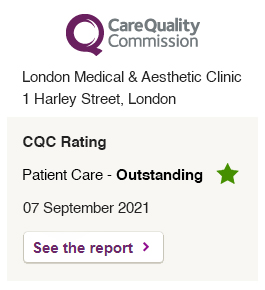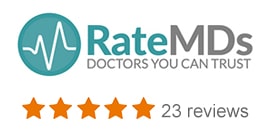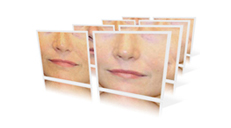London Medical and Aesthetic Clinic was the first clinic in the UK and Europe to introduce the revolutionary SmartSkin CO2 laser resurfacing system, brought by Dr Ayham Al-Ayoubi, a world-recognised pioneer in laser and minimally invasive cosmetic surgery.
Our fractional micro-ablative CO2 laser treatment offers a safe and highly effective solution for sun damage, stubborn pigmentation, acne scarring, rough texture, enlarged pores, fine lines, wrinkles and mild skin laxity. It can be used on the face, neck, chest, arms, hands and even on surgical scars. With minimal downtime, patients notice smoother, fresher and more youthful skin shortly after treatment.
The SmartSkin Performa CO2 laser represents the latest generation of skin resurfacing technology. Its precision, customisability and advanced energy delivery allow for fast, visible improvement while keeping recovery time to a minimum — making it a preferred choice for patients seeking powerful results with a more comfortable treatment experience.
Dot Resufacing Laser
SmartSkin’s Dot Resurfacing technology represents one of the most advanced developments in modern CO2 laser rejuvenation. Using a fractional delivery system combined with an ultra-fast scanning pattern, the SmartSkin Performa allows the doctor to create precise “micro-dots” of ablation across the skin. This controlled pattern is what gives the treatment its name: Dot Resurfacing. It enables targeted renewal of damaged skin while preserving surrounding healthy tissue, which speeds up healing and enhances overall comfort.
Dot Resurfacing works by delivering a finely controlled beam of thermal CO2 energy to the skin’s surface. Instead of removing the entire outer layer, the laser creates thousands of microscopic treatment zones. These tiny columns of ablation break down damaged cells, smooth irregular texture and encourage rapid regeneration of fresh, healthy skin. At the same time, the surrounding untreated skin supports faster recovery.
As the skin heals, new collagen is formed and the surface gradually becomes smoother, clearer and more even in tone. Lines, wrinkles, pigmentation patches, acne scars and roughness soften, while the skin takes on a healthier, rejuvenated appearance. Because only fractional “dots” of skin are treated, downtime is significantly reduced compared with traditional fully ablative CO2 resurfacing—yet the results remain highly effective.
SmartSkin CO2 Laser Use
SmartSkin Performa CO2 laser can be used to treat these concerns to resurface the skin all over the body:
- Age (sun) spots
- Dark circles under the eye
- Dry, dull skin
- Fine lines
- Freckles
- Hand rejuvenation (age spots, loose skin, and lines)
- Melasma
- Redness and flushing
- Scars
- Stretch marks
- Wrinkles
The skin rejuvenation process is safe for most skin types and colours.
CO2 Laser Suitability
Co2 laser treatment is suitable for people who have sun damage, stubborn pigmentation, acne scars, rough texture, enlarged pores, fine lines, wrinkles and skin laxity on the face, neck, chest, arms and hands and surgical scars and the skin rejuvenation process is safe for most skin types and colours.
The photo below shows the wrinkle removal results achieved with the new Performa CO2 micro fractional ablative laser with only 4-6 days of down time as compared to 3-4 weeks of down time and 3 months of redness with a trditional CO2 Laser resurfacing.
The new micro fractional ablative Performa CO2 laser resurfacing techniques are very exciting advances in the field of non surgical facial rejuvenation and wrinkle removal.
Many new applications are being used to improve our ability to rejuvenate the skin and improve scars, stretch marks, and remove pigment. New digital multi-functional software allows us to customize power, dwell time, density and scan patterns to perfectly balance your cosmetic and downtime needs.
Latest CO2 Laser Technology
CO2 lasers for resurfacing were introduced in the mid 1990’s and changed the landscape of aesthetic medicine overnight.
The initial lasers were continuous wave with very little control and delivered less than stellar results with many adverse effects compared to modern day resurfacing. However, the continuous wave CO2 lasers led to the development of pulsed and scanned CO2 lasers and eventually pulsed, scanned Er: YAG lasers.
The next generation of Erbium technology offered much more control to deliver better results with significantly reduced downtime and adverse events. The increase in pulsed resurfacing lasers led the industry down a path to discover lasers with lower downtime and less adverse effects.
This then gave way to the rise of the fractional laser technology. Fractional lasers offered acceptable results with a much lower downtime and almost no adverse effect but it did require more treatments. Ablative fractional lasers remove small columns of epidermal and dermal tissues, which then regenerate into brand new tissue.
Non-ablative Fractional lasers create microscopic zones of tissue injury which become remodeled, however it does not remove tissue like an ablative laser does. The development in these lasers continued to lower the downtime but required even more treatments to achieve the desired results.
Therefore, for the last decade, patients who did not desire to have deep, full field Er:YAG laser resurfacing, which offered the best results but prolonged downtime, were given two options. They could either choose ablative fractional treatments (fewer sessions, more downtime) or non-ablative fractional treatments (more sessions, fewer downtime).
Today, new resurfacing technology has completely revolutionized the theory that better results require either more downtime or more treatments.
HALO, the world’s first Hybrid Fractional laser, combines the best attributes of both non-ablative and ablative fractional lasers. Now, patients can get ablative-like results with non-ablative-like downtime.
By adding tuneable ablation to a non-ablative treatment creates varying effects when different levels are used.
Before and After photo gallery
The SmartSkin Performa CO2 LaserSkin Renewal workstation, with a cusomizable scanning delivery system, combines micro ablative CO2 skin resurfacing and collagen rejuvenation in a single laser.
Laser skin resurfacing uses a specially crafted beam of thermal energy that breaks down and removes only the very outer layers of the area of skin. This leaves the skin more even as well as encouraging new skin to grow with a healthier look.
The light associated with CO2 lasers is able to stimulate skin rejuvenation, only hitting small areas in depth thanks to Performa SmartSkin fractional DOT technology. This is due to micro beams only targeting a proportion of the skins surface at one time, which allows faster healing, causing a tightening of the skin and stimulation of collagen production, thereby, giving a younger and softer looking skin.
With the Performa CO2 laser fractional microablative resurfacing the laser beam is broken up or fractionated into many small micro beams which are separated so that when they strike the skin surface small areas of the skin between the beams are not hit by the laser and left intact. These small areas of untreated skin promote a much more rapid recovery and healing with less risk of complications.
Dr Ayham Al-Ayoubi explains: “In the above skin diagram, the first red area on the left represents traditional ablative CO2 and Erbium laser resurfacing. To ablate means to surgically remove and the skin tissue is removed by the heat of the CO2 or Erbium laser and since these lasers were not fractional, all of the skin in the treated area is removed creating an open wound that takes a long time to heal.”
The second drawing is the fractional CO2 laser which fractionally ablated the surface of the skin down to a depth of 70-100 microns. This laser is fractional and the skin heals much quicker, but depth of penetration is not deep enough to produce substantial wrinkle removal, skin tightening and skin rejuvenation.
The third red areas represent non ablative fractional laser technologies which heat but do not ablate the skin. This laser heats small columns of the deep skin layers to promote new collagen production and plump the skin and skin wrinkles. Recovery time is much less than with traditional ablative CO2 and Erbium lasers. This laser procedure is excellent for improving skin texture, plumping wrinkles and acne scars, and shrinking pores.
The Performa CO2 fractional micro ablative lasers which have bee
n developed to actually remove the heated column of skin tissue and provide more substantial wrinkle removal and superficial skin tightening than the non ablative fractional lasers (See last figure on right in above diagram). This new micro ablative fractional Performa CO2 laser has the advantage of producing better wrinkle removal and skin rejuvenation.
These fractional micro ablative Performa CO2 lasers reach much deeper into the skin, 600 to 1000 microns, and can produce much more effective wrinkle removal and skin rejuvenation with significantly less down time and recovery than traditional CO2 and Erbium non fractional ablative laser resurfacing.
During the procedure, the SmartSkin laser will be used to effectively stimulate and rejuvenate both the outer (epidermis) and inner (dermis) layers of your skin.
The SmartSkin is comprised of a C02 laser that is applied to the treatment areas with a unique scanning handpiece. The laser has a wavelength of 10,600 nm and delivers laser pulses to the skin that measure 350 µm in diameter. Each laser pulse creates a micro-zone of ablation in the epidermis, and the number of pulses in a given area can be carefully controlled.
Adjusting the spacing of the laser pulses allows us to leave some of the skin surface untouched, leading to faster healing and less downtime. We also control the timing and power level of the pulses, allowing for more or less aggressive procedure outcomes.
CO2 Laser Treatment
This exciting new SmartSkin laser treatment is performed by Dr Ayham Al-Ayoubi, a specialist laser Surgeon. The SmartSkin CO2 laser treatment is quick, lasting only 15 to 45 minutes. A full-face treatment takes up to one hour. The doctor may treat wrinkles around your eyes, mouth, or forehead individually or treat the entire face.
Depending on the degree of damage to the skin and desired results, most patients require 1-3 SmartSkin CO2 laser treatments, spaced 4 – 6 weeks apart and usually a course of treatments are required two to four weeks apart.
Local anaesthetic is applied prior to SmartSkin CO2 laser treatment. There is slight discomfort during the procedure. Rarely, a mild burning sensation may occur. Topical anaesthetic is required and protective eye shields must be worn.
Laser skin rejuvenation and resurfacing is a gentle laser treatment for wrinkles and sun damage. This no-downtime procedure is appropriate for the face but also for the chest, neck and hands – anywhere that sun damage shows.
Performa micro ablative laser uses the very latest and most sophisticated laser technology to resurface the skin resulting in just a few days of redness. The results start to appear after a week or so, but continue to develop for 3-6 months.
A typical patient would receive one to three Performa CO2 laser skin resurfacing treatments. During each one, the laser creates thousands of microscopic spots, almost like tiny.
With the Performa SmartSkin CO2 micro ablative resurfacing the laser beam is broken up or fractionated into many small micro beams which are separated so that when they strike the skin surface small areas of the skin between the beams are not hit by the laser and left intact.
These small areas of untreated skin promote a much more rapid recovery and healing with less risk of complications. The small areas treated by the Performa micro beams, called micro treatment zones, cause sufficient laser injury to promote new collagen production and resultant facial skin rejuvenation.
Swelling after laser skin resurfacing is normal. The doctor may prescribe steroids to manage swelling around your eyes. Sleeping on an extra pillow at night can also ease swelling. The patient may feel itching or stinging for 12 to 72 hours after the procedure.
Five to seven days after laser resurfacing, the skin will become dry and peel. Depending on the problem that was treated, healing typically takes 4-10 days. Once the skin heals, patients can wear oil-free make-up to minimize redness, which usually fades in two to three months.
Patients will also probably notice that their skin is lighter for a while after surgery. It is particularly important that they use a “broad-spectrum” sunscreen, which screens ultraviolet B and ultraviolet A rays, to protect the skin during that time.
When selecting a sunscreen, look for one specially formulated for use on the face with a sun protection factor (SPF) of 30 or higher. Patients must limit the time in the sun, especially between the hours of 10 a.m. and 2 p.m., and wear protective clothing, such as long-sleeved shirts, pants, and a wide-brimmed hat.
It is also important to keep the new skin well moisturized. If the patient uses glycolic acid products, he/she should be able to start using them again after about six weeks or when the doctor says they can.
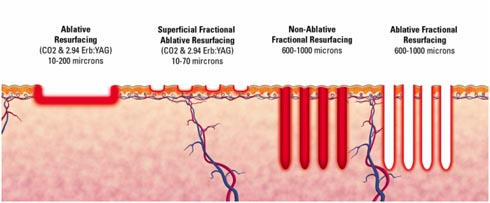
Following laser resurfacing, a sterile dressing is applied to the treatment sites for 1-2 hours. Patients will be required to clean the treated areas every 3-4 hours with sterile water which will be supplied by our clinic as well as an ointment which is used to soothe and protect the skin.
This after care is intended to prevent the skin from drying out. In general, the areas heal in 3-5 days, depending on the nature of the condition that was treated. The new skin can remain pink for several days after but can be concealed with camouflage make-up.
Darker pigments and freckles may get darker after the initial laser skin rejuvenation and resurfacing treatment and flake off in a few days. All these changes are normal and the recovery depends on the individual and the treatment strength performed. Blisters are extremely rare and because the lasers reduce wrinkles by encouraging new collagen growth, wrinkle improvement is gradual.
Heat build up occurs in the skin during the laser procedure and is managed with cold air gently directed over the epidermis. Redness of the skin usually occurs and lasts one to three days. (Make-up can be applied the following day.) Expect very mild peeling to take place over the first week.
Unlike traditional laser skin resurfacing, blistering and crusting does not usually occur for several days following the procedure. Dryness of the skin is treated using petroleum jelly, forming a seal that prevents further water loss. There is a very small risk of pigment change and scarring following laser treatment.
SmartSkin CO2 Laser Safety
The SmartSkin Performa CO2 laser has received FDA approval in the USA and CE Mark certification in Europe for skin rejuvenation and resurfacing and can dramatically improve the skin appearance without the downtime and discomfort usually required with traditional resurfacing.
The SmartSkin Performa laser skin rejuvenation is a micro ablative, non-invasive procedure whereby the surface of the skin is not damaged or removed. The gentle lasers correct pigmentation irregularities and encourage new collagen growth to smooth out existing facial wrinkles.
The primary target of the C02 laser is water. Once it has passed through the epidermis, the laser energy is delivered to the deeper, collagen bearing tissues below. It is this interaction of water, the C02 laser, and collagen that ultimately leads to the collagen rejuvenation and skin tightening that is one of the hallmarks of a SmartSkin procedure.
By removing a customized pattern of dots and not the entire skin surface, unlike other CO2 lasers, this technology combines the best of both worlds – the great and proven results of a traditional ablative laser, but without the pain and the traditional downtime.
Because of this “Dot Resurfacing” only a percentage of the surface area is affected during each Performa laser treatment, this technology combines the best of both worlds – the great and proven results of a traditional ablative laser with no pain and no downtime.This laser treatment does not require general anaesthetic because the scanner is so precise, sophisticated and fast.
No other fractionated CO2 laser is as versatile. This versatility allows customized treatments to specific needs. Brown age spots, wrinkles, fine lines, sagging eyelid skin can all be treated with the Performa laser.
Mr Ayham Al-Ayoubi explanins: “SmartSkin CO2 laser delveres a precise level of energy that’s required based on how I personally perform the procedure and not on a predetermined setting on a machine and the small areas treated by the fractional micro beams, called micro treatment zones, cause sufficient laser injury to promote new collagen production and resultant facial skin rejuvenation without affecting the suroounding tissue.”
There is no evidence to suggest whatsoever that SmartSkin Performa CO2 laser treatment can be linked to skin disorders or increased risk of skin cancer.
SmartSkin CO2 Laser At Our Clinic
Since we began offering SmartSkin Performa laser treatment for skin resurfacing, demand has grown steadily and now Smartskin laser treatment hasbecome one of the most popular skin rejuvenation treatments available.
Patients travel from all over the UK and from around the world to have Dr Ayham Al-Ayoubi perform SmartSkin CO2 laser skin resufacing treatment at our Clinic in London, which is one of the leading centres for laser skin treatments in the UK and Europe.
Dr Ayham Al-Ayoubi the very first facial plastic and laser surgeon to introduce and poineer SmartSkin CO2 laser into the UK in 2008. One year later, he pioneered this revolutionary CO2 laser worldwide.
Our laser clinic is registered with the Health Care Commission ensuring the highest level of safety for our patients.
CO2 Laser FAQs
Below are answers to some of the most common questions patients ask about CO2 laser treatment. At London Medical and Aesthetic Clinic, we believe every patient should feel informed, confident and supported throughout their treatment journey, so we have provided clear explanations to help you understand what to expect.
What is the CO2 laser used for?
Fractional micro-ablative CO2 laser resurfacing is used to treat a wide range of skin concerns, including sun damage, stubborn pigmentation, enlarged pores, acne scars, rough or uneven texture, fine lines, wrinkles and mild skin laxity. By creating thousands of controlled micro-channels in the skin, the laser removes damaged cells on the surface while stimulating deeper tissue to regenerate. This process leads to smoother, clearer and more youthful-looking skin. The treatment can be performed on multiple areas—including the face, neck, chest, arms, hands and surgical scars—and because it is fractional rather than fully ablative, patients benefit from impressive results with minimal downtime compared to older CO2 technologies.
Is CO2 laser painful?
Most patients find CO2 laser resurfacing very tolerable because a topical numbing cream is applied before treatment, ensuring the skin is desensitised and the laser energy is not felt as pain. During the procedure, some patients describe a warm or prickling sensation, but this is usually mild. After the treatment, the skin may feel tender, warm or slightly inflamed—similar to a light sunburn—but this is a normal part of the healing response and typically settles over the next few days. Any swelling or redness that appears is temporary, and patients are given clear aftercare instructions to keep discomfort minimal.
Is CO2 laser safe?
Yes—when performed by an experienced doctor, CO2 laser resurfacing is considered very safe. The SmartSkin Performa CO2 system used at our clinic is both FDA-approved and CE-marked, meaning it has undergone rigorous testing for safety, effectiveness and quality. The laser allows precise control over depth, density and energy levels, which helps to protect the surrounding tissue while achieving strong rejuvenation. Compared with older fully ablative CO2 lasers, SmartSkin’s fractional technology significantly reduces downtime, discomfort and risks, making it a trusted and widely used option for skin renewal.
What is the recovery time for CO2 laser?
Recovery varies depending on the patient and the strength of the treatment, but most people experience redness for around 2–3 days before the skin begins to settle. Dr Ayoubi prescribes antiviral medication and antibiotics as a precaution to prevent infection and reduce the risk of herpes simplex flare-ups, which is standard practice for high-quality clinics. Patients are also advised to cleanse the skin gently with a diluted water-and-vinegar solution several times a day, as this helps reduce bacteria on the newly exposed skin layer and supports healing. Most people feel comfortable returning to normal daily activities fairly quickly, although sun protection and proper skincare are essential during the recovery phase.
How long after CO2 laser will I see results?
Patients often notice an immediate improvement in skin freshness and smoothness once the initial healing has taken place, but the full results develop gradually over 6–12 weeks as new collagen forms. The initial healing phase can last anywhere from 3–14 days, depending on the treatment depth, and it is completely normal for the skin to appear pink for several weeks afterwards as it continues to regenerate. This subtle pinkness is simply a sign of increased blood flow to the healing tissue and fades naturally over time. As collagen production increases, lines, pigmentation, texture irregularities and scars continue to improve, revealing a clearer and more youthful complexion.
What are the possible side effects of CO2 laser?
The most common side effects include temporary redness, swelling, warmth or itching, all of which are normal signs of the skin’s repair process and usually settle without issue. The SmartSkin CO2 system is designed to minimise risks by treating only micro-columns of skin at a time, but—as with any resurfacing procedure—rare complications can occur. These may include infection, scarring, changes in pigmentation or blistering, though such issues are highly uncommon when the treatment is performed correctly and proper aftercare is followed. Dr Ayoubi’s expertise and precise technique help ensure the highest levels of safety and the lowest likelihood of side effects.
Does CO2 laser remove scars?
Yes—fractional CO2 laser resurfacing is considered one of the most effective non-surgical treatments for acne scars, particularly deeper or more complex scars that do not respond well to lighter modalities. The laser penetrates into the deeper layers of the skin where scar tissue forms, breaking it down while stimulating new collagen to rebuild the area more smoothly. In addition to acne scarring, CO2 laser can improve surgical scars, stretch marks, pigmentation patches, age spots, melasma, redness and textural irregularities. Results improve progressively over several weeks as the skin continues to remodel.
Does CO2 laser stimulate collagen?
Yes—stimulating collagen is one of the key benefits of CO2 laser resurfacing. The controlled heat from the laser triggers the skin’s natural wound-healing response, which leads to increased production of new collagen fibres while also strengthening existing ones. This collagen remodelling helps firm the skin, soften wrinkles, reduce scarring and improve texture over time. Because collagen continues to rebuild for several months, patients often notice ongoing improvement long after the initial treatment has healed.
Will CO2 Laser cause acne-prone skin to break out or form acne scars?
The laser Doctor should provide the patient with correct treatment protocol to prevent the acne recurrence.
Dr Ayoubi have been treating acne scars for more than 25 years and he had found that a combination of Sculptra (with subcision) and SmartSkin CO2 laser laser give the best long lasting results for atrophic, acne and indented scars.
patients should be aware that everyone has a unique pattern of acne scarring, and most people have various types of scars and a tailored treatment plan for each patient should be made depending on the severity of the acne scars, skin type and age group. In most of the cases acne needs a combination approach for long-term improvement.


